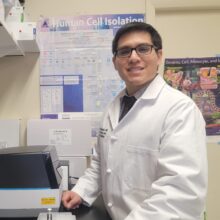The path of discovery is not often a straight line. Most times it winds around from one question to another. Sometimes the trail just stops until someone else with a vision comes along and imagines where that dead end can go.
When Dr. Julio Huapaya arrived at the NIH for a fellowship in pulmonary and critical care medicine, he was eager to work on interstitial lung disease in those with autoimmune conditions like myositis. He was surprised, however, to discover that, despite the vast resources of the NIH and the prevalence of pulmonary fibrosis, studies on interstitial lung disease (ILD) were conspicuously lacking. This revelation inspired the pulmonologist to focus his research on understanding this chronic condition that causes scarring of the lungs making it difficult to breathe.
“We don’t have really good treatments for pulmonary fibrosis,” says Dr. Huapaya. “We really need to change this. So I thought, why don’t we look at biomarkers in autoimmune interstitial lung disease? It would add one more piece of data to our understanding.”
With the help of one of his mentors, Dr. Sonye Danoff, Dr. Huapaya began to explore ILD biomarkers, signs that can be measured in blood, urine, and tissue to help identify whether a condition is getting better or worse. Autoantibodies are one such biomarker in those with autoimmune conditions. Dr. Huapaya also believed certain ILD autoantibodies could also cause disease.
But measuring autoantibodies is a challenge. Currently available testing measures—ELISA and the Western blot—are not good at quantifying the proteins they are testing for. This makes them insufficient as a measure of disease activity.
One of his mentors, however, Dr. Anthony Suffredini, was aware of work that had been done a decade or more ago to develop a blood test that could measure autoantibodies more accurately than the usual tests.
Developed by Dr. Peter Burbelo, this novel test was called luciferase immunoprecipitation system (LIPS). It had been used to identify autoantibodies in patients with acute respiratory failure. One of these antibodies turned out to be one for antisynthetase, the condition that most often leads to myositis ILD. Dr. Huapaya was excited to explore this technology for measuring autoantibodies associated with myositis ILD.
Testing his idea on a handful of blood samples, he was able to show that this new blood test could accurately measure myositis autoantibodies levels. More testing would need to be done on patients, however, to be sure LIPS could be used as a new way to understand the many layers of myositis diseases.
Using the data from this small study as support, in 2023 Dr. Huapaya applied for a two-year, $100,000 TMA Research Fellowship Grant to continue his quest for a biomarker of ILD. Now he is working to expand his initial research, using LIPS to solidify the role of autoantibody levels in ILD diagnosis and management. He is hoping this technology will be sensitive enough to detect myositis autoantibodies even before the onset of symptoms.
Still, the fact that the LIPS assay has been seemingly forgotten for more than a decade puzzled Dr. Huapaya.
“You know, Dr. Burbelo created this assay ten plus years ago, and I couldn’t understand why we are not using it,” Dr. Huapaya says. “Part of the reason is nobody thought that antibodies were what caused disease, so they never explored that route.”
The other reason, according to Dr. Huapaya’s mentor was that he never had the chance to collaborate with someone who had the kind of interest in autoantibodies as biomarkers…until Dr. Huapaya came along.
Now there are studies suggesting that these antibodies may actually cause disease, which may give us a new target for drug therapy for ILD and other myositis conditions. And now, thanks to a TMA Research Fellowship award, Dr. Huapaya is eager and able to do the necessary research to explore these questions.
If you value work like Dr. Huapaya’s, please consider making a contribution in support of TMA’s Research Grants Program. The myositis community would all be grateful.

An interesting article. My question is Has any research been done on any interaction with the Covid vaccine/ Covid infection? My disease showed up after my 3rd vaccine and my thyroid stopped working!
Hello Carla. We’re so sorry to hear you seem to have been affected by the COVID vaccine. There is a group called COVAD (COVID-19 Vaccination in Autoimmune Disease) that is doing a lot of work in this area. If you do a search in PubMed, you’ll find a whole list of research articles from studies they’ve done. https://pubmed.ncbi.nlm.nih.gov/?term=covad. Here is one article that studied vaccine adverse events in people who have myositis: https://pmc.ncbi.nlm.nih.gov/articles/PMC9349921/. Bottom line: they’re still saying “Whilst there is a paucity of long-term safety and efficacy data of COVID-19 vaccination in patients with autoimmune diseases, the current evidence strongly suggests that the benefits of vaccination outweigh the risks of adverse effects and disease flares.” Hope this helps.
How do I volunteer for such studies? I have Anti-synthetase syndrome (2024) with Dermatomyositis and ILD since 2020 and just last year i was hospitalised for 3 times and just this year 1 time….I did rituximab in oct but it doesn’t seem to improve. Would like to find out more. Thx
Diana, Dr. Huapaya is not working with patients at this time. You can find clinical trials involving myositis, ILD, antisynthetase syndrome here: https://www.myositis.org/research/clinical-trials/clinical-drug-trials/. This study, also at the NIH, is assessing myositis patients of all kinds, including those with ILD and antisynthetase syndrome: https://www.clinicaltrials.gov/study/NCT05738824.